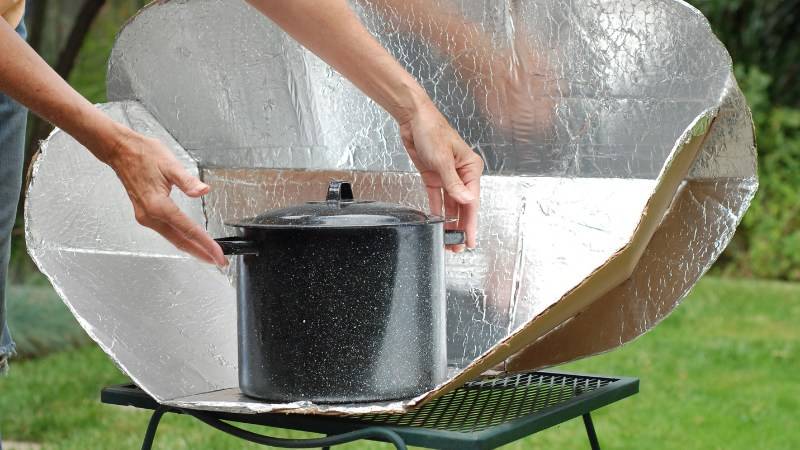I used to think gas stoves were the only way to cook efficiently—until I saw my monthly fuel bill skyrocket.
Between propane refills and electricity costs, I was burning through money just to make a simple meal.
Then, I discovered solar stoves—a clean, cost-effective way to cook using nothing but sunlight. No gas. No electricity. No emissions. Just pure, renewable energy.
Solar stoves aren’t some futuristic gadget; they’ve been around for decades, but few people realize their potential. They can boil water, fry eggs, bake bread—even slow-cook a stew—all without relying on fossil fuels. But are they practical for daily cooking? Can they truly replace traditional stoves?
In this guide, we’ll talk about how solar stoves work, how they compare to regular stoves, and if they’re easy to use. Wondering if a solar stove is right for you? I’ll help you decide—and share some of the best eco-friendly brands to check out!
What Is A Solar Stove?
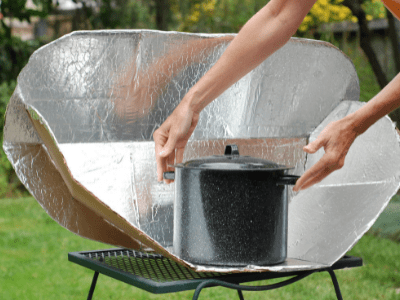
A solar stove is a cooking device that uses solar energy to heat and cook food. Instead of relying on gas, electricity, or wood, it harnesses sunlight and converts it into heat, making it a fuel-free and eco-friendly alternative.
All solar stoves follow the same basic principle: they capture, concentrate, and retain solar energy to generate the heat needed for cooking. Some models use reflective panels to direct sunlight to a cooking pot, while others rely on vacuum tubes or parabolic mirrors for greater efficiency.
These stoves are perfect for off-grid living, camping, hiking, and emergency preparedness—anywhere you need a hot meal without relying on traditional fuel sources. With zero emissions and no fuel costs, they’re a sustainable way to cook while reducing your carbon footprint.
Solar Stoves Vs. Traditional Stoves – Which One Is Better?
For a long time, solar stoves had a bad reputation. People thought they were slow, unreliable, and just another survival gimmick. But solar cooking technology has come a long way.
Today’s solar stoves are efficient, durable, and capable of cooking anything from stews to grilled meals—without using gas, wood, or electricity.
How Solar Stoves Work vs. Traditional Stoves
Solar stoves operate by capturing solar energy and converting it into heat, eliminating the need for gas, propane, wood, or charcoal. They use reflective panels, evacuated glass tubes, or parabolic mirrors to concentrate sunlight onto a cooking surface.
Once the heat is absorbed, it is retained within an insulated cooking chamber or a heat-trap enclosure, ensuring efficient cooking with no reliance on fossil fuels. Since they burn no fuel, solar stoves produce zero emissions, making them a clean and eco-friendly cooking solution.
Traditional stoves, on the other hand, rely on combustible fuels to generate heat. Whether powered by natural gas, propane, firewood, or charcoal, these stoves require a steady fuel supply to function.
This dependence on fuel not only increases long-term costs but also presents challenges for those cooking in remote areas or off-grid locations.
Additionally, burning fuel releases carbon dioxide (CO₂), smoke, and other air pollutants, contributing to environmental degradation and indoor air pollution.
Key Differences
| Feature | Solar Stoves | Traditional Stoves |
|---|---|---|
| Fuel Source | Sunlight (Free & Renewable) | Gas, Wood, Charcoal (Costly & Limited) |
| Eco-Friendliness | Zero Emissions, No Air Pollution | Produces CO₂, Smoke, Soot |
| Ease of Use | Set & Forget | Requires Fuel, Fire Management |
| Cooking Time | Slower, Depends on Sunlight | Faster, Works Anytime |
| Portability | Lightweight & Great for Outdoors | Heavy, Needs Fuel Supply |
Is a Solar Stove Worth It?
If you love camping, hiking, or off-grid living, a solar stove can be a game-changer—no need to haul fuel or worry about running out of gas. It’s clean, cost-effective, and great for the environment.
However, solar stoves do depend on sunlight, so they may not be the best choice for cooking late at night or on cloudy days. That said, newer models retain heat well and can cook even in low-light conditions.
Types Of Solar Stoves
Solar stoves come in different designs, each using solar energy in a unique way to cook food. While all solar cookers rely on the same principle—capturing, concentrating, and retaining sunlight to generate heat—their efficiency, cooking speed, and best use cases vary.
1. Panel Cookers: Simple and Lightweight Solar Stoves

Best For: Slow cooking soups, casseroles, and stews.
Panel cookers are the most basic type of solar stove, designed with shiny reflective panels that direct solar radiation toward a central cooking area.
The cooking pot sits inside a transparent heat-trap, such as a glass bowl or plastic cover, which prevents heat loss and helps maintain a steady temperature.
These solar-powered cookers work best in direct sunlight and are ideal for slow-cooked meals like soups, stews, and casseroles.
Although affordable and highly portable, panel cookers require longer cooking times and may not reach the high temperatures needed for frying or baking.
2. Box Cookers: Efficient and Versatile Solar Ovens

Best For: Everyday cooking, baking, and slow-roasting.
Box cookers, often called solar ovens, are one of the most widely used solar stoves due to their versatility and efficiency.
They feature an insulated cooking chamber with a clear glass lid that traps heat, similar to a greenhouse effect. Large reflective panels help increase solar absorption, allowing the stove to reach higher temperatures than panel cookers.
The interior is usually painted black to maximize heat retention. Box cookers are great for baking, roasting, and general-purpose solar cooking.
Their steady and reliable heating makes them a preferred choice for people who want a more traditional solar-powered cooking experience.
3. Parabolic Cookers: High-Heat Solar Stoves for Fast Cooking
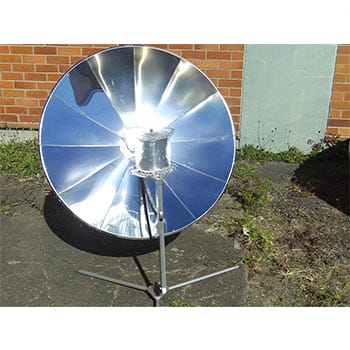
Best For: Grilling, frying, boiling water quickly.
Parabolic cookers are high-performance solar stoves that use a curved, dish-shaped reflector to focus sunlight onto a single focal point.
This concentrated solar power generates extremely high temperatures—often between 500°F and 700°F (260-371°C)—making them suitable for grilling, frying, and boiling water rapidly.
Unlike panel and box cookers, which take longer to heat up, parabolic solar cookers can reach cooking temperatures quickly but require frequent adjustments to keep the focal point aligned with the sun.
While powerful, they are bulkier and less beginner-friendly compared to other solar cooking systems.
4. Tube Cookers: Advanced Solar Cooking with Heat Retention
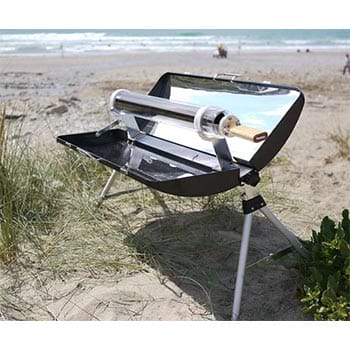
Best For: Cooking in cooler or cloudy conditions.
Tube cookers are one of the most advanced types of solar stoves, designed for high heat retention and all-weather solar cooking.
They use a vacuum-sealed glass tube surrounded by shiny reflector panels to capture and trap solar heat efficiently. These solar-powered ovens can reach temperatures of 550°F (290°C) or higher, making them ideal for roasting meats, baking bread, and steaming vegetables.
Unlike other solar stove designs, tube cookers can maintain heat even in cloudy conditions, thanks to their thermal insulation.
Although they are more expensive, their fast heating, high efficiency, and weather resistance make them a top choice for serious solar cooking enthusiasts.
Each solar stove design has its own advantages. Choosing the best solar stove for your needs depends on your cooking style, climate, and how often you rely on solar power for outdoor or off-grid cooking.
How Does A Solar Stove Work?
A solar stove works by converting the sun’s energy into heat, unlike most solar products that use photovoltaic panels to convert the sun’s energy into electricity.
To achieve this, solar stoves have components that concentrate, absorb, and retain heat.
The first components are metal or metallic foil reflectors, panels, and other reflective surfaces. It’s their job to direct the sunlight to a concentrated point, which is usually a black insulated vessel.
These reflectors are placed all around the oven to speed up the heating.
The cooking pot should be dark-colored because dark colors absorb heat more easily. Also, it helps if the pot is thin, so it can transfer the heat to the food faster and more evenly.
Now the stove needs to trap the heat. Since solar ovens need to be well-insulated to achieve the “greenhouse effect,” the heat trap is transparent. It can be a cooking bag, a glass bowl, or something like that.
If you’ve ever entered a car that has been sitting outside for a few hours on a sunny summer day, you already know how this process works.
Now imagine your car in the same spot, surrounded by large reflecting mirrors.
Ouch!
Apart from trapping heat, the transparent cover allows more sunlight to reach the cooking port and raise the cooking temperature.
This is why you should always make sure the oven has a continuous supply of the sun’s energy to reflect, convert, and absorb. This means you need to adjust the solar stove constantly.
Who Would Benefit From A Solar Stove?
People Who Live Off The Grid
Solar stoves are perfect for people living off the grid. With the lack of a power grid, the only source of energy for people comes from renewables and fossil fuels. Solar panels are becoming cheaper every day, and their efficiency is increasing.
However, preparing food with heat consumes a lot of electricity, which portable panels still can’t deliver.
This is where solar cookers come in. They use the same energy source like solar panels, but much more efficiently for the given purpose of generating high heat.
Campers And Hikers
Solar cookers come in several different configurations and if you get a camp stove, you can carry it in a backpack or at least strap it to your rig.
Free cooking using solar power has many advantages over other ways of cooking in the wilderness.
First, you don’t have to forage for dry twigs and branches, which can be an impossible task after the rain. A camp stove works the same just after the shower as it would on a bright sunny day. Second, you can save yourself from the fire hazard that comes with cooking on an open flame.
Preppers
Solar cookers are also popular among people who like to be prepared for whatever comes next, be it a massive blackout pulse from outer space or the zombie apocalypse.
Funny references aside, in emergencies such as state-wide power failures, storms, floods, and other extreme weather events, hot food can mean a lot.
So whether you’re preparing for the day the deadly machines will take over or simply want to be prepared for the next natural disaster, a quality solar stove should have a place in your bail-out kit.
Eco-Conscious Folks
Finally, solar ovens benefit people who care about the environment and are always looking for ways to reduce their carbon footprint.
Instead of using your gas stove or electric oven day after day, why wouldn’t you all gather in the backyard, deploy your camp stove, and have quality time in fresh air while the sun cooks your dinner?
After all, you should keep in mind that apart from serving valuable resources, a solar oven can help you with your electricity bills. Solar cooking uses literally zero electrical power and contributes to zero emissions.
Benefits Of Using A Solar Stove
Clean Energy
Solar cooking is the cleanest and most environmentally friendly way of preparing food known today. It uses only the power of the sun, while physics does all the rest.
Its alternatives are much more unacceptable in the environmental sense. For example, wood or coal stoves leave nasty byproducts like soot and ash, not to mention the CO2 and other residues that are dispersed into the atmosphere.
Using a propane camp stove might be a bit greener, but natural gas is also considered a depletable resource that also needs a lot of energy to extract, refine, and transport.
Portable
Dragging fuel for a traditional stove or grill while camping really beats the idea of traveling light, not to mention self-sufficiency and living off the land. Thanks to their compact size and small weight, solar camp stoves are easy to pack and deploy wherever you need a hot meal.
Unlike their counterparts that use wood or coal, solar cookers like the GoSun Grill are perfect for situations where apart from available space, weight is luxury, as well. If you can take one stove on a 30ft sailing boat for a 20-day journey, would it be a solar stove or something else?
Easy To Clean
A solar camp stove does not use gasoline or any other fuel that produces soot, so it’s much easier to clean than its dirty-technology counterparts. The only thing you need is soapy water and a cloth to wipe any food or grease that might have gotten stuck to the reflecting panels.
Easy cleaning can also be time-saving, especially if you’re enjoying the great outdoors and have a lot of activities to attend to.
Since nothing is burned, you also don’t have to deal with ash and embers that always pose a risk in the wooded areas where the ground is bristling with pine needles or dry leaves.
Healthy Meals
Solar ovens cook food more slowly so it retains its flavor. For example, meat is more tender and nutritious compared to regular ovens. Because of the solar trap, these ovens are also great for retaining the moisture in your food.
When you use a solar stove, it’s practically like a slow cooker that uses free solar power instead of electricity. If, for example, you’re using a solar camp stove that cooks at 180°F (82°C), you can rest assured that the food or water is free from microorganisms that chase disease.
And since the food cooks gently at temperatures lower than in regular ovens, it retains the nutrients and rarely overcooks or burns.
Temperature Adjustment
At a regular oven, it’s easy to adjust the temperature — just turn the knob and set the heat that you need. But did you know that you can easily adjust the temperature on a solar cooker as well?
When using a solar camp stove, you can regulate the temperature in several ways. You can lower the temperature by taking it out of the sun, opening the door of the cooking area, or closing up the main sun catcher panels.
To raise the temperature, you only need to make sure your solar camp stove is oriented directly to the sun.
Safe And Easy
A great thing about solar ovens is that you need to prepare the ingredients and put them inside. No other prep work needed. What is more, since solar stoves don’t burn any fuel, you don’t have to worry about open flames or burns.
This feature makes solar ovens great for folks with children or pets as well as busy families.
Another benefit of solar cooking is that you don’t have to monitor the food constantly. Just put everything in and you can go about your business.
Great For Remote Areas
Lastly, a solar oven is a valuable resource in areas that experience limited access to fuel and electrical power. Whether you’re camping on the banks of the Yukon or in the Mojave desert, it’s absolutely the same for your solar camp stove.
More importantly, solar stoves are easy to build which makes them attractive for low-income communities that may have difficulties accessing fuel or electricity.

Read More:
Disadvantages Of A Solar Stove
Like all devices that run on solar power, solar ovens need sunlight to work. This makes them less useful during winters when days are shorter, and absolutely useless at nighttime.
They are also not recommended for those living in cold climates, as the cold air can negate the heat accumulated by the reflectors.
A solar oven might not be of much use during storms, while on overcast days only tube cookers can generate enough heat.
Also, since the success of cooking depends on a lot of sunlight, some people might find it annoying having to constantly adjust and reorient the device.
Other users might be put off by the long cooking time when compared to a regular oven. With solar ovens, you need to prepare and start cooking your meal early in the morning. This can be inconvenient for people who have busy working schedules.
Things To Consider When Buying A Solar Stove
Reflective Panels
All solar cookers have some kind of reflective panels that they use to reflect and concentrate solar energy into the cooking area where the food is cooked.
As a rule, the bigger and higher quality of the panels, the more heat the oven can produce, and the faster and more even the cooking will be. On the other hand, ovens with collapsible reflectors technology are always an advantage as you can pack them in your car more easily.
Temperature Range
This is one of the most important elements as it determines how hot the solar oven can get and how much time it needs to cook the food.
To cook your food properly, you need at least 180°F (82°C). Water, for example, can pasteurize at about 150°F (65°C), so it’s important to get a solar oven that can easily achieve those temperature ranges.
As a rule, you should look for stoves that can reach at least 250°F (121°C) in the cooking area, as this allows you to cook a variety of meat, pastries, soups, and stews.
On the other hand, if you want to grill, you need a model, like a GoSun solar stove, that reaches between 300-400°F (148-204°C).
Portability
This largely depends on the type of solar oven you choose. If you like to trek a lot, or go camping frequently, get a smaller, more portable oven. For example, there are foldable panel cookers you can easily fit into your backpack, but these usually cook slower.
Another great option for people on the go is the solar energy tube oven. Unlike foldable cooker types, they reach high temperatures quickly, but on the downside, they can cook for one, maximum of two persons.
If you don’t worry about the space, you should choose a panel oven or parabolic oven. These models are much more versatile, have reasonable cooking times, but are a bit heavy to carry around.
Thermometer
A temperature gauge is probably one of the most important things to look at when shopping for a solar energy cooker.
Sure, if you only need a solar oven to brew coffee or boil tea, then you don’t need the thermometer. But, if you need an oven that easily achieves high temperatures for cooking, then you also need to tell what the temperature is. Roasting and baking can be really tricky if you don’t know how hot your solar oven got.
Versatility
There are solar cooker types that can only get your coffee going or boil water for your tea. On the other hand, there are more versatile cookers that let you stew, boil, fry, grill, and even roast meat, fish, and vegetables.
If you’re about to pay for a quality product, it’s always better to find a solar stove that supports a wide range of cooking methods. A versatile stove should also allow you to cook different types of food as well.
Accessories
You can find the best solar oven you can buy, and then realize that you still miss some items to start preparing meals. You don’t need extra costs, so make sure the oven you buy comes with all the accessories you need.
Most solar cookers come with accessories such as cooking pans, cleaning items, an instruction manual, and even a cookbook, where you can find some recipes that are custom-written for the exact oven model.
5 Solar Stove Brands Leading the Way in Sustainability
Not all solar stoves are created equal. Some brands go beyond just providing an alternative to gas or charcoal—they focus on sustainability, ethical production, and reducing environmental impact.
Here’s a look at five leading solar stove brands, their green initiatives, and how they are making a difference.
1. GoSun – Innovation & Off-Grid Sustainability
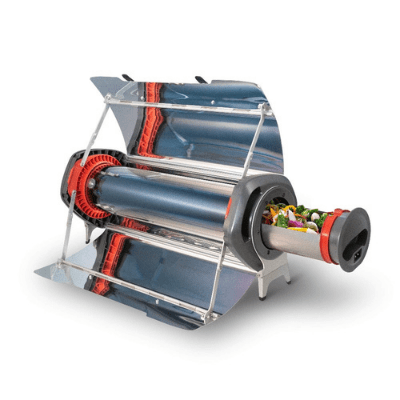
GoSun is one of the most innovative brands in solar cooking, offering solar ovens, solar-powered coolers, and even water purifiers.
Their technology uses evacuated tube heating, which traps solar energy efficiently, allowing their stoves to work even in cloudy conditions.
Beyond products, GoSun is committed to energy independence and environmental sustainability. By replacing fossil fuel-based cooking methods, their solar appliances help reduce carbon footprints.
GoSun also partners with non-profits to bring solar cooking solutions to off-grid communities, helping people cook with clean energy instead of relying on wood, propane, or electricity.
2. Haines Solar Cookers – Low-Cost Solar Stoves for a Bigger Cause
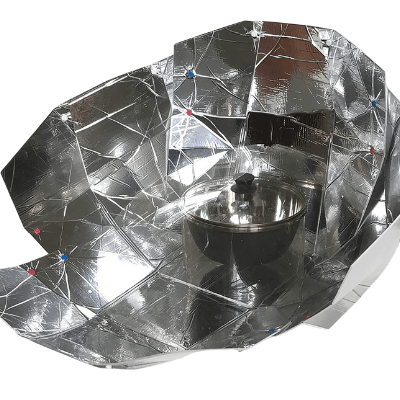
Haines Solar Cookers focuses on affordable and effective solar cooking solutions, particularly for people in developing countries. Their stoves use reflective panels to capture sunlight and generate heat for cooking meals without firewood, gas, or charcoal.
The brand actively supports humanitarian projects. Through partnerships with organizations like Fair Climate Fund, they have distributed thousands of solar cookers to refugee camps in Chad.
This initiative helps combat deforestation, air pollution, and fuel poverty, making their stoves a true sustainability tool for real-world impact.
3. Energy Wise – Portable Solar Cooking for Everyday Use
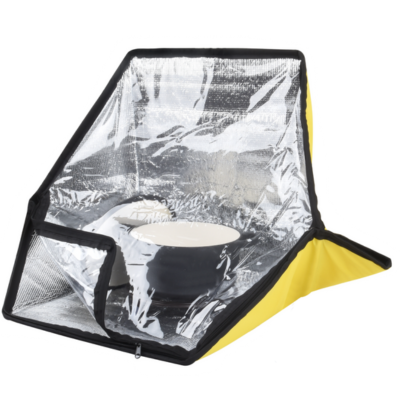
Energy Wise creates compact and easy-to-use solar cookers, designed for people who want a portable, eco-friendly way to cook outdoors.
Their solar ovens use reflective panels to concentrate solar heat, making them a great alternative to firewood-based or gas-powered cooking.
Beyond solar stoves, Energy Wise promotes energy-efficient products like insulated attic covers to help homes reduce energy consumption. Their mission is to make sustainable living easier, helping people cut down on fuel use and carbon emissions with simple, practical solutions.
4. Sunflair – Making Solar Cooking Accessible for Everyone

Sunflair specializes in lightweight, foldable solar ovens, making solar cooking easy, portable, and affordable.
Their products require no fuel, making them an ideal eco-friendly cooking option for camping, emergencies, and off-grid living.
The company strongly promotes sustainable living by encouraging people to switch from fuel-based cooking to solar-powered alternatives. They provide recipes, cooking guides, and solar cooking tips, helping more people embrace green, fuel-free cooking methods.
5. SolCook – Promoting Solar Cooking Through Education & Donations

SolCook is known for its All-Season Solar Cooker, a durable and adjustable solar stove that works in different sunlight conditions.
Their products are made to last, using high-quality reflective panels that maximize solar energy absorption.
However, SolCook does more than just sell stoves. They focus on education and community outreach by donating solar cookers to underprivileged areas and running free solar cooking classes.
They also sponsor sustainability events to raise awareness about solar-powered cooking as a practical, clean-energy solution.
Why These Brands Matter for Sustainability?
All five of these solar stove companies are leading the way in reducing reliance on fossil fuels, promoting clean energy, and making solar cooking more accessible worldwide.
Whether through innovative technology, affordability, education, or humanitarian aid, they are proving that solar-powered stoves are more than just an alternative—they are part of a sustainable future.
If you’re looking for a solar stove that aligns with your values, these brands are some of the best to consider.
Frequently Asked Questions (FAQ)
Yes, solar power can run a stove. Solar camp stoves are designed to reflect available sunlight into a heat trap in the center of the oven, where you place the cooking dish. Quality solar stoves can cook pretty much everything a regular stove can.
Yes, solar ovens really work and can be successfully used for preparing a variety of meals and hot drinks. They are 100% environmentally-friendly because they don’t burn any fossil fuels but run on solar power only. They are especially popular among people living off the grid.
No, we can’t use a solar cooker at night. Solar cookers depend on continuous sunlight supply to work, so they are completely useless after dark. Portable solar ovens that use vacuum tubes, can however work under cloudy skies and less-than-ideal sunlight conditions.
Yes, you can boil water in a solar oven. You can bring water to boil in all types of solar ovens. However, not many people know that to make water safe to drink you only have to pasteurize it, not necessarily sterilize. You can pasteurize water by heating it to 149°F (65°C) for 6 minutes.
You can cook a wide variety of foods and hot drinks in a solar oven. It mainly depends on the oven type and the temperature it can achieve and hold. Basic solar ovens can brew coffee, cook soups, stews, and casseroles, while more advanced ones can even grill and fry.
The success of solar cooking is affected by the available sunlight and the adjustment of the solar oven. Most portable solar ovens need plenty of the sun’s energy to cook food evenly and within a reasonable time frame. This means that you need to adjust your solar oven so it always faces the sun directly.
It depends on the oven type. Solar box ovens typically reach temperatures around 300°F (150°C), which is enough to cook most foods. Parabolic solar ovens, like GoSun solar products, on the other hand, are more efficient and can reach a temperature of about 500°F (260°C).
Solar cooking takes longer than a regular kitchen oven because the temperature isn’t as high or as constant. As a rule, the same recipe takes 1.5-3 times longer in a solar oven. The practical cooking time depends on the type of oven, weather, type of cookware, type of food, etc.
It depends on the type of oven. Panel ovens are considered the least efficient and may not give satisfactory results on cloudy days. Parabolic and tube cookers reach much greater temperatures and will be able to cook on cloudy days, as well.
You can make your solar oven faster by using a dark cooking vessel, as dark colors help absorb the heat more easily. You should also use a vessel that is thin, so it transfers the heat to the food more quickly and evenly.
Ready to Ditch Fuel and Cook with the Sun?
Imagine never having to buy gas, propane, or charcoal again—just placing your pot under the sun and letting solar energy do the work. Solar stoves aren’t just a cool gadget for campers; they’re a sustainable cooking solution that can help you save money, reduce pollution, and cook anywhere—even off the grid.
Switching to a solar-powered stove means saying goodbye to fuel costs, harmful emissions, and the hassle of hauling firewood. Whether you’re looking to cut down your carbon footprint, embrace eco-friendly cooking, or prepare for off-grid adventures, a solar stove is a simple yet powerful way to make a difference.
If you’re ready to make the switch, explore the best solar cooking options today and start harnessing the power of the sun for a cleaner, greener way to cook.

